Test Bank -Memory Foundations And Applications (Download To Score An A)
Document Content and Description Below
The search for the “engram” was the search for a) the physical location of retrieval operations in the brain. b) the processes that link language and memory. *c) the physical location in the br... ain of specific memories. d) the actual weight of the brain in kilograms. In Quiroga et al.’s (2005) neuroimaging study, it was found that a) cells in the parietal cortex only responded when the word “Engram” was repeated. b) cells in the visual cortex responded but only when complex stimuli were deleted from the scene. *c) cells in the visual cortex responded to a particular “person” regardless of whether that person was presented as photograph or as a written name. d) cells in the parietal cortex responded to the repetition of episodic memories. Traumatic brain injuries *a) occur when the brain violently and suddenly hits a hard object, such as an automobile windshield. b) occur when the brain experiences a temporary lack of blood flow. c) occur when we think too hard. d) occur when the brain cannot handle its cognitive workload. What are neurons? *a) They are biological cells that specialize in the transmission and retention of information. b) They are multi-cellular parts of the brain responsible for encoding engrams. c) They are the cells that cover axons and protect the flow of information in the nervous system. d) They are viruses that disrupt the workings of memory and can be classified as TBIs. Which two features makes neurons unique biological cells? a) soma and nucleus b) protoplasm and ribosomes c) mitochondria and nucleus *d) axons and dendrites Which part of the neuron receives information from other neurons? a) axons b) nucleus *c) dendrites d) myelin Which part of the neuron transmits information to other neurons? *a) axons b) nucleus c) dendrites d) myelin In between the axon of one neuron and the dendrite of the next is a small space, in which neurotransmitters are released. This space is known as the *a) synapse b) fovea c) somatic cleft d) terminal button Transmission of information along the axon takes place via a electrochemical process called the a) synaptic flow b) neuronal junction c) dendritic gap *d) action potential The disease, Multiple Sclerosis (MS), is caused by a) the loss of neurons in the spinal cord. *b) the loss of myelin sheaths, which protect the axon. c) the loss of neurotransmitters in the substantia nigra of the brain. d) the loss of mirror neurons in the frontal lobe. Neurotransmitters are proteins that a) cause neurons to wither and die. *b) bridge the synapse and induce or inhibit an electric current in a dendrite. c) react to neuronal firing, thereby causing conscious experience. d) replace aging neurons in older adults. In Parkinson’s Disease, a) Myelin sheaths erode, causing erratic transmission of information to the muscles. *b) The substantia nigra no longer produces an adequate supply of the neurotransmitter, dopamine. c) Axon potential occurs at lower thresholds, thus triggering the characteristic shaking. d) Dendrite degenerate, leaving neuronal transmission at dangerously low levels. Many legal and illegal drugs (such as nicotine and LSD) affect the nervous system by a) destroying neurons. *b) altering the amount of neurotransmitters in the synapse. c) making the synapse itself smaller. d) causing axons to swell, thus speeding transmission. Studies have shown that songbirds with damage to the left hippocampus a) no longer remember migratory routes. *b) no longer learn species-typical songs. c) lose their ability to spatially navigate by the earth’s magnetic fields. d) show immediate compensation in the right hemisphere. Although most modern neuroimaging research shows that there is much cross-talk and sharing of function across the hemispheres of the brain, it has been generally found that *a) the left hemisphere specializes in language, whereas the right hemisphere specializes in spatial cognition. b) neither hemisphere is responsible for memory; that is solely the domain of the limbic system. c) the corpus callosum only transmits a small amount of information across the hemispheric boundary. d) the right hemisphere is largely dormant; it is only used when the left hemisphere is damaged. Which of the following are NOT functions of the cerebral cortex? a) language and memory. b) creativity and emotion. c) attention and inhibition of impulses. *d) regulation of sleep and breathing. The function of the hippocampus in memory processing is thought to be a) the storage of old episodic memories. *b) the encoding of new long-term memories. c) source monitoring. d) storage of engrams. The hippocampus and the amygdala are part of which brain system? a) The reticular formation b) The diencephalon system c) The Raphe complex *d) The limbic system Damage to the hippocampus is associated with which problem? a) sleep deprivation b) hyperamnesia c) a lack of conscious awareness *d) amnesia In birds, the hippocampus is associated with what function? a) control of flight b) thermoregulation *c) memory d) problem-solving The amygdala is most associated with what aspect of human behavior? *a) emotion b) sex c) hunger and thirst d) higher cognition The diencephalon is critical to memory because a) memories are stored in this area. *b) it connects the limbic system to areas of the brain in the pre-frontal lobe. c) visual information is largely processed in the diencephalon. d) its neurons are sheathed in neurotransmitters more than other areas. The names of the four lobes of the cerebral cortex are a) anterior, posterior, exterior, and inferior. *b) frontal, parietal, temporal, and occipital c) dorsal, lateral, littoral, and limbic. d) neuronal, reticular, somatosensory, and embryonic. The role of the occipital lobe is a) audition. b) the senses of smell, taste, and touch. c) creativity and music. *d) vision. Among the functions of the parietal lobe are a) regulation of hunger and thirst. *b) attention and the somatosensory system. c) control of complex movement. d) understanding language. The part of the temporal lobes involved in memory are called the a) parietal temporal junction. b) the pre-temporal lobe. *c) the medial temporal lobe. d) the mammillary bodies. Damage to the medial temporal lobes can cause *a) amnesia b) agnosia c) amusia d) prosopagnosia The pre-frontal lobes appear to be important in which memory functions? a) encoding new information b) storing old information *c) metamemory and self-regulation d) adding visual imagery to verbal memories Source memory is mostly a function of the *a) pre-frontal lobes. b) temporal lobes. c) limbic system. d) hippocampus. Novel items in the Von Restorff effect show up as bigger p300 waves using a) fMRI b) PET *c) EEG d) DOGs EEG measures the a) magnetic activity in the brain. b) small vibrations along axons. *c) the sum total of electrical activity in the brain, as measured on the scalp. d) only activity in the cerebral cortex and not activity in the limbic system. Which of the neuroimaging techniques requires a small amount of radioactivity to be injected into the bloodstream? *a) PET b) fMRI c) MRI d) EEG Cabeza and Nyberg (1997) showed, using PET technology, that a) PET and MRI are functionally equivalent when looking at memory responses. *b) the right pre-frontal lobe was involved in retrieval from memory. c) areas of the hippocampus are activated as soon as person experiences the PET scan. d) the left occipital lobe is involved in encoding into semantic memory. The term MRI means to ____ imaging and the term fMRI refers to ________ imaging. *a) structural; functional b) hypothetical; free c) visual; focused d) neurological; fantastic Koshino et al (2008), using fMRI found that autistic individuals, relative to controls, a) were equivalent in episodic memory performance. b) showed no activity at all in the left prefrontal lobe. c) showed higher levels of activation throughout the frontal lobes. *d) showed lower levels of activation in areas of the left prefrontal lobe, known to be involved in working memory. The patient HM suffered anterograde amnesia after removal of a) his occipital lobe. b) parts of his frontal lobe. c) the retina of his left eye. *d) both hippocampi. Retrograde amnesia refers to a) difficulty learning new events. *b) difficulty retrieving old events. c) difficulty retrieving words in sentences. d) an enhanced ability to retrieve episodic events. Anterograde amnesia refers to *a) difficulty learning new events. b) difficulty retrieving old events. c) difficulty retrieving words in sentences. d) an enhanced ability to retrieve episodic events. Neuropsychological patients contribute to our understanding of the brain because a) scientists can correlate the damage in the brain with the cause of the trauma. *b) scientists can correlate the damage in the brain to the deficits in function. c) brain damage is always manifested in deficits in behavior. d) brain damage cannot be measured by conventional cognitive tests. Drugs called cholinergics have been shown to improve memory in a) college students b) rats c) healthy older adults *d) patients with Alzheimer’s Disease Which class of drugs, available by a prescription, is associated with temporary amnesia? a) cholinergics b) endorphins c) nicotine-derivatives *d) benzodiazepines The strong connection between the sense of smell is mediated by what pathway in the brain? *a) the connections between the olfactory bulb and the limbic system. b) the connections between the olfactory bulb and the occipital lobe. c) the connections between the lateral geniculate nucleus and the hippocampus. d) the connections between the lateral geniculate nucleus and the anterior cingulate gyrus. Research on music and the brain shows that a) the brain has no role in music perception or memory. b) professional musicians show more activity in the hypothalamus while performing than do amateurs. c) the left hemisphere is more active in amateurs than it is in professionals. *d) the right hemisphere is heavily involved in music processing. Which of the following statements are false? a) the brain is divisible into two symmetrical halves, oriented in the left-right direction. b) The cerebral cortex is the outer layer of the brain most associated with higher cognitive and emotional functioning. c) Amnesia means memory deficits acquired through brain damage. *d) The thalamus of the brain is an integral part of the occipital lobe. Which lobe of the brain is associated with the sense of touch (somatosensory system) *a) parietal. b) temporal. c) occipital. d) maniacal. With transcranial magnetic stimulation (TMS), a) accurate images of sub-cortical brain structure can be recovered. *b) temporary disruption of certain brain regions can occur. c) Korsakoff’s disease can be reversed. d) the magnetic impulses of the brain can be accurately collected. Which of these neuroimaging techniques presents some health risks to the participant because it uses radioactive tracers. a) fMRI b) structural MRI *c) PET d) MEG Lucus is an 57-year old man who suffered a stroke to his medial temporal lobe. What outcome might you expect with Lucus? *a) He will show some anterograde amnesia. b) He will not be eligible for an fMRI c) Exposure to TMS will correct any cognitive deficits. d) He will show a selective deficit in source monitoring and motion detection. MEG technology is based on a) sensing the flow of electrons through the brain. *b) detecting the magnetic fields created by the brain. c) taking an optical picture of a brain prior to surgery. d) tracing the flow of blood in the cortex. Phineas Gage and HM are *a) well-known neuropsychological patients. b) researchers who developed the fMRI technique. c) are important areas in the Limbic system. d) are important brain regions the prefrontal lobe. Chapter 4 The scientist who formalized the distinction between episodic and semantic memory is a) Hermann Ebbinghaus b) Martin Conway *c) Endel Tulving d) Elizabeth Loftus Rickie knows that Angela Merkel is the name of a chancellor of Germany. Rickie is retrieving this information from storage in a) autobiographical memory b) semantic memory *c) episodic memory d) pedantic memory Lola tells a story about the time she went in a hot-air balloon with her father when she was nine years old. She is retrieving this story from a) semantic memory b) the philogical loop c) prospective memory *d) episodic memory Episodic memory concerns the memory for ____, whereas semantic memory concerns the memory for ______ a) facts, words b) lists, witnessed events *c) personal events, facts d) strictly words, strictly images Retrieval from episodic memory draws on *a) more right prefrontal lobe processes than does semantic memory. b) more cerebellar processes than does semantic memory. c) more cognitive processes than does semantic memory. d) the same neural regions as working memory. The highly salient memories people have of their own circumstances during major public events are called a) public event memories b) salutatory memories c) repressed memories *d) flashbulb memories Episodic memories, compared to semantic memories, are often a) more difficult to maintain over long periods of time. *b) more likely to be oriented to the past. c) more difficult to express in words. d) less likely to be emotional. “Remember” judgments are associated with ____, and “know” judgments are associated with________ *a) episodic memory; semantic memory b) semantic memory; episodic memory c) working memory; semantic memory d) working memory; autobiographical memory Tulving’s patient KC shows memory deficits for *a) episodic memory only. b) episodic and semantic memory, but not working memory. c) the ability to generate visual images. d) episodic memories from early childhood only. The term that means that brain damage (or an experimental variable) can affect one cognitive system, but leave another one intact is *a) dissociation b) amnesia c) hyperagnosia d) hyperamnesia According to the HERA (Hemispheric Encoding/Retrieval Asymmetry) model of memory, for episodic memory encoding is more based in the *a) the right medial temporal lobe than the left prefrontal lobe. b) the parietal lobe than the amygdala. c) the two hemispheres are equally active. d) the left pre-frontal lobe is more involved than the right pre-frontal lobe. According to the HERA (Hemispheric Encoding/Retrieval Asymmetry) model of memory a) both semantic and episodic memory make use of the pre-frontal lobes in an identical manner. b) there is no pattern in which hemisphere is more involved in retrieval. c) episodic memory is not processed in the frontal lobes. *d) right pre-frontal cortex is more involved in the retrieval of episodic memory. Representation, in memory science, means *a) how we store information when it is not currently in use. b) how we learn new information. c) if we will enter the memory into our prospective memory system. d) is synonymous with episodic memory, but is an older term. Activating information already stored in long-term memory is called a) encoding b) representation c) episodic memory *d) retrieval The cognitive psychologist’s term for learning is *a) encoding b) representation c) episodic memory d) retrieval Levels of processing is based on the assumption that a) all learning takes place in a semantic vacuum. b) episodic memory and semantic memory are similar but not identical. *c) that most learning is incidental, not intentional. d) that higher levels lead to worse memory performance than lower levels. Incidental learning means that a) that encoding takes place without attention. *b) that people encode information not by actively trying to remember but rather as by-product of perceiving and understanding the world. c) that people encode information by actively trying to remember but also without regard to content matter. d) that people encode information in a haphazard manner. Intentional learning means that a) that people encode information not by actively trying to remember but rather as by-product of perceiving and understanding the world. *b) that people actively engage in learning information because they know that their memories may be tested. c) that people learn by early sensory processing. d) that ill intention seldom leads to long-term recall. Elaborative processing means that we a) process for shallow sensory characteristics. b) deliberately study, as in preparation for a test. *c) process for meaning. d) encode via prospective means. In the levels of processing framework, better memory is produced when we *a) use deeper level processing. b) use sensory processing. c) use maintenance rehearsal. d) trust our semantic memories. In the experiment by Craik and Tulving (1975), orienting tasks were used to a) allow all participants to process deeply. c) maximize the ability of participants to encode the material. c) control whether semantic or episodic memories were being used. *d) control the level of processing. Craik and Tulving (1975) found that a) orienting tasks were not useful for memory improvement. *b) orienting tasks that promoted deeper processing led to better memory. c) orienting tasks that promoted sensory processing led to better memory. d) memory performance was not affected by the orienting tasks. Sporer (1991) showed that people were better at recognizing faces if they had first processed them in terms of whether or not the face looked “honest” or not than if they had processed them in terms of whether or not the person had a wide nose. This is consistent with a) encoding specificity. *b) levels of processing. c) retrieval inhibition. d) cross-race representation. What is the term for the observation that linking to-be-learned information to personally-relevant information about oneself creates strong encoding? a) survival processing. *b) self-reference effect. c) the mirror effect. d) encoding reversal. Survival processing means that a) we remember the words we learned when we feel as if our lives are threatened, as in weapon focus. b) people more prone to use deeper processing are more likely to survive evolutionarily. *c) focusing on the relevance of words to surviving in an imaginary grasslands leads to strong memory traces. d) the more we study certain words, the more they will “survive” in memory. That memory is better when we generate associations ourselves than when we simply read of see them is known as the a) the primacy effect. *b) the generation effect. c) the self-reference effect. d) the mirror effect. Slameka and Graf (1978) demonstrated the generation effect by devising an experiment in which a) by preventing elaborative rehearsal by using irrelevant speech. *b) they compared pairs in which participants read the items to pairs in which participants generated the target item. c) by providing no clues to the participant as to how to complete the stimulus pairs. d) by subtly manipulating the likelihood of sub-conscious generation. Butler and Roediger (2007) gave some students a lecture summary whereas other “students” received short answer tests with feedback if the participants for half of the answers. A final control group of participants did not get a summary nor did they receive a short answer test. The group that did the best on a later test was a) the control group. b) the group given lecture summaries. c) all groups performed equivalently. *d) the group that received short-answer tests. According to the enactment effect, a) actors have exceptional memories. b) acting out one’s repressed memories brings a relief of emotional distress. *c) performed tasks are remembered better than those that are simply read about. d) state-dependent memory occurs only under mood-congruent situations. Organization leads to deeper levels of processing. The king of organization that leads to the best memory performance is *a) self-organization. b) mood-congruent organization. c) survival organization. d) incidental organization. Consider the following list of words: crocodile, salamander, gecko, alligator, turtle, newt, saxophone, tortoise, iguana, toad. The Von Restorff effect means that a) “crocodile” will be remembered well because it is at the beginning of the list. b) “iguana” and toad will be remembered well because they are at the end of the list. *c) “saxophone” will be well remembered because it benefits from distinctiveness. d) “gecko” will be well remembered because of its position in the serial position curve. One potential application of the Von Restorff effect is to *a) focus on the distinctive aspect of a stimulus you want to remember. b) always use subjective organization. c) focus on the first item in a list as it is always defines the category. d) recognize situations in which levels of processing does not predict performance. The Von Restorff effect works because a) the isolated item always occurs in a critical serial position. b) mood congruence can account for why we remember off-color or offensive words. c) encoding specificity applies to representation as well as encoding. *d) distinctiveness implies that we search for the unique meaning for each item. The distinction between availability and accessibility is a) availability means retrieval from episodic memory, whereas accessibility means retrieval from semantic memory. *b) availability means everything that is represented in memory, whereas accessibility means that which we can retrieve at the moment. c) availability means encoding, whereas accessibility means retrieval. d) availability means those memories which require a retrieval cue, whereas accessibility means those memories easily maintained in working memory. The concept of accessibility implies that a) everything we ever perceive is stored in memory. *b) retrieval cues are necessary to unlock some memories. c) in some cases, retrieval should occur before encoding. d) the limbic system is involved in episodic memory. Encoding specificity means that a) retrieval cues do not apply to semantic memory. b) deeper processing leads to stronger memory representations. *c) retrieval of information from memory will be maximized when the conditions at retrieval match the conditions at encoding. d) we remember happy events from our life better when we are currently happy. In Godden and Baddeley’s (1975) experiment, scuba divers remembered best when a) they were tested on land. b) they were tested underwater. c) they retrieved in the opposite environment that they learned in. *d) they retrieved in the same environment that they learned in. In Godden and Baddeley’s experiment on encoding specificity, the results revealed that *a) if a diver studied underwater, he or she remembered more when tested underwater. b) if a diver studied underwater, he or she remembered more when tested on land. c) if a diver studied underwater, he or she remembered better when tested under the influence of alcohol. d) if a diver studied underwater, he or she remembered better when tested with nicotine. Eich et al. (1975) examined the influence of marijuana on people’s memory. He found that a) marijuana is always a memory enhancer. b) participants preferred learning when not using marijuana. c) marijuana hurts memory performance even in working memory tests. *d) state-dependent learning applies to drugs, such as marijuana. Eich et al. (1975) found that *a) if a person studies when under the influence of a drug, he or she does best when tested under the influence of the same drug. b) certain drugs can improve memory. c) marijuana hurt memory performance, but nicotine improved it. d) if person studies under the influence of a drug, he or she does best when tested sober. Eich and Metcalfe (1989) induced their participants into either happy moods or sad moods during encoding. They found that *a) participants retrieved best when they were in the same mood as they were when they learned the information. b) participants retrieved best when they were in sad moods. c) participants retrieved best when they were in happy moods. d) participants retrieved best when they were in the opposite mood as they were when they learned the information. Mood congruence means a) Moods are best remembered when we study them under levels of processing. b) that we remember the moods we are in later, when it is congruent to do so. c) that you are more likely to remember events if you are in the same mood as when you learned them. *d) that you are more likely to remember events that is positive when you are in a positive mood and more likely to remember events that is negative when you are in a negative mood. Inhibition refers to a) a mechanism that promotes decay from working memory. b) conscious refusal to acknowledge painful memories. c) encoding specificity applied to repressed memories. *d) a mechanism that actively interferes with and reduces the likelihood of recall of particular information. Retrieval-induced inhibition means that *a) the retrieval of some items interferes with the retrieval of related items later. b) the retrieval of some items interferes with the retrieval of the same items later. c) the retrieval of category names interferes with the retrieval of category exemplars. d) the retrieval of category names interferes with the retrieval of studied exemplars. In Anderson et al.’s (1994) experiment on retrieval-induced inhibition, participants a) RP+ (retrieval practiced category; studied items) items are recalled worse than NRP (not studied) items. b) RP- (retrieval practiced category; unstudied items) items are recalled better than NRP (not studied) items. *c) RP- (retrieval practiced category; unstudied items) items are recalled worse than NRP (not studied) items. a) RP+ (retrieval practiced category; studied items) items are recalled worse than RP- (retrieval practiced category; unstudied items) items. Akiko studies half of the countries of Europe, but not the other half. When tested on her knowledge of European countries, Akiko is likely to show a) mood-congruence; she’ll remember the countries that she studied when she was in a good mood. b) levels of processing; she’ll remember the countries that she studied using perceptual priming. c) maintenance rehearsal; she’ll remember those countries that she is keeping in working memory. *d) part-set cueing; she’ll remember those countries she studied well, but will retrieve the remaining half worse than if she had not studied. In directed forgetting, participants are asked to forget certain items. This results in a) ironically, enhanced memory for those items. b) participants cannot inhibit the to-be-forgotten items, resulting in greater recall of those items. c) participants do not follow the directions and forget all of the items. *d) participants inhibit the to-be-forgotten items, resulting in less recall of those items. Part-set cueing occurs *a) if a person studies only half the items in the list. The unstudied items are less likely to be recall compared to a control group that did not study any of the items. b) if a person studies only half the items in the list. The unstudied items are more likely to be recall compared to a control group that did not study any of the items. c) if a person studies only half the items in the list. The unstudied items no more or less likely to be recall compared to a control group that did not study any of the items. d) when the person is directed to forget all of the items. Scullin and Bugg (2012) examined prospective memory. They found one error that occurred in prospective memory was *a) repeating a task that had already been performed. b) not directing their forgetting to prospective memory. c) indicating that their memory was semantic not episodic. d) not checking the clock when they were supposed to. Which of these brain regions has been shown to be critical in prospective memory tasks? a) the cerebellum. b) the Largent temperata. c) the medial surface of the parietal lobe. *d) areas in the pre-frontal lobe. [Show More]
Last updated: 1 year ago
Preview 1 out of 7 pages
Instant download
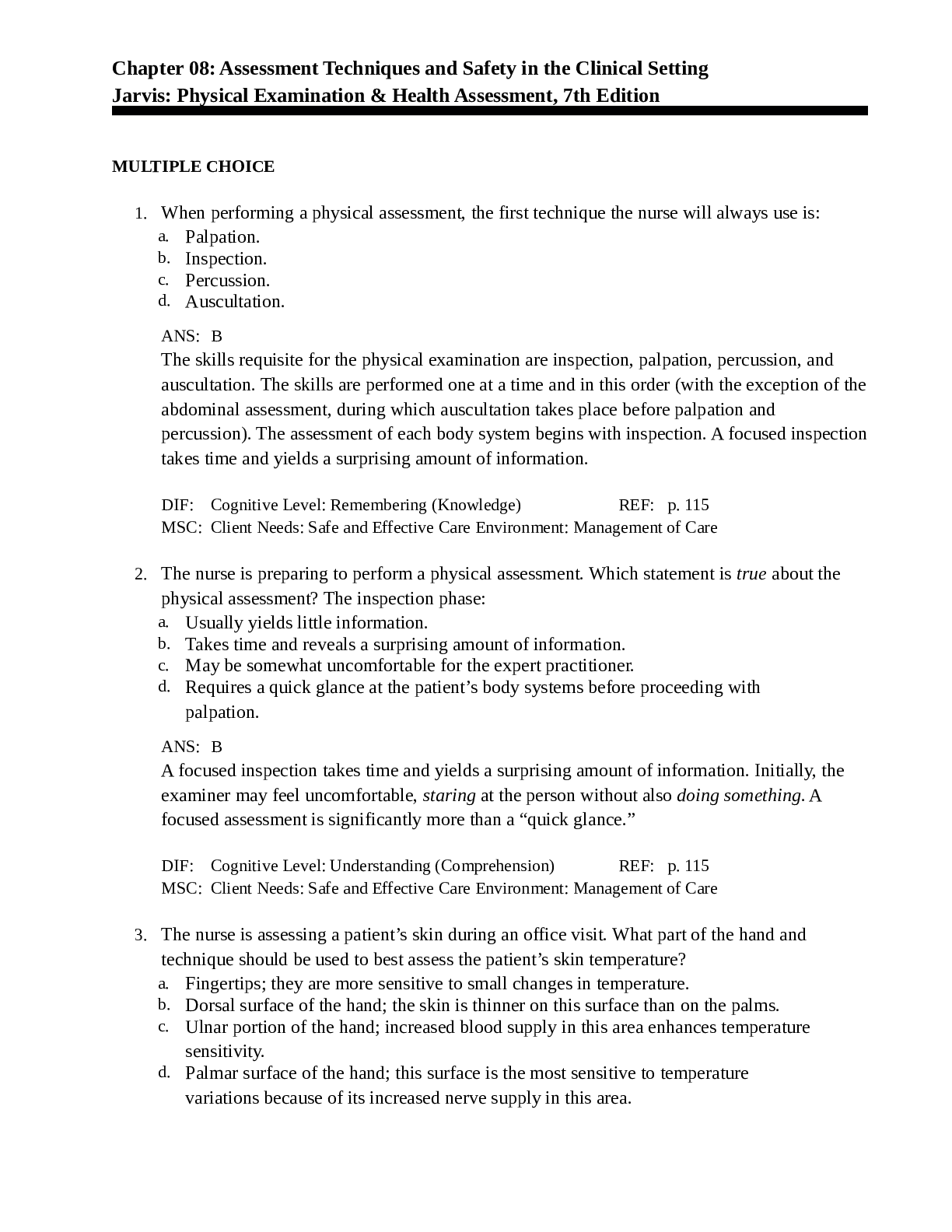
Buy this document to get the full access instantly
Instant Download Access after purchase
Add to cartInstant download
Reviews( 0 )
Document information
Connected school, study & course
About the document
Uploaded On
Feb 15, 2021
Number of pages
7
Written in
Additional information
This document has been written for:
Uploaded
Feb 15, 2021
Downloads
0
Views
46






.png)






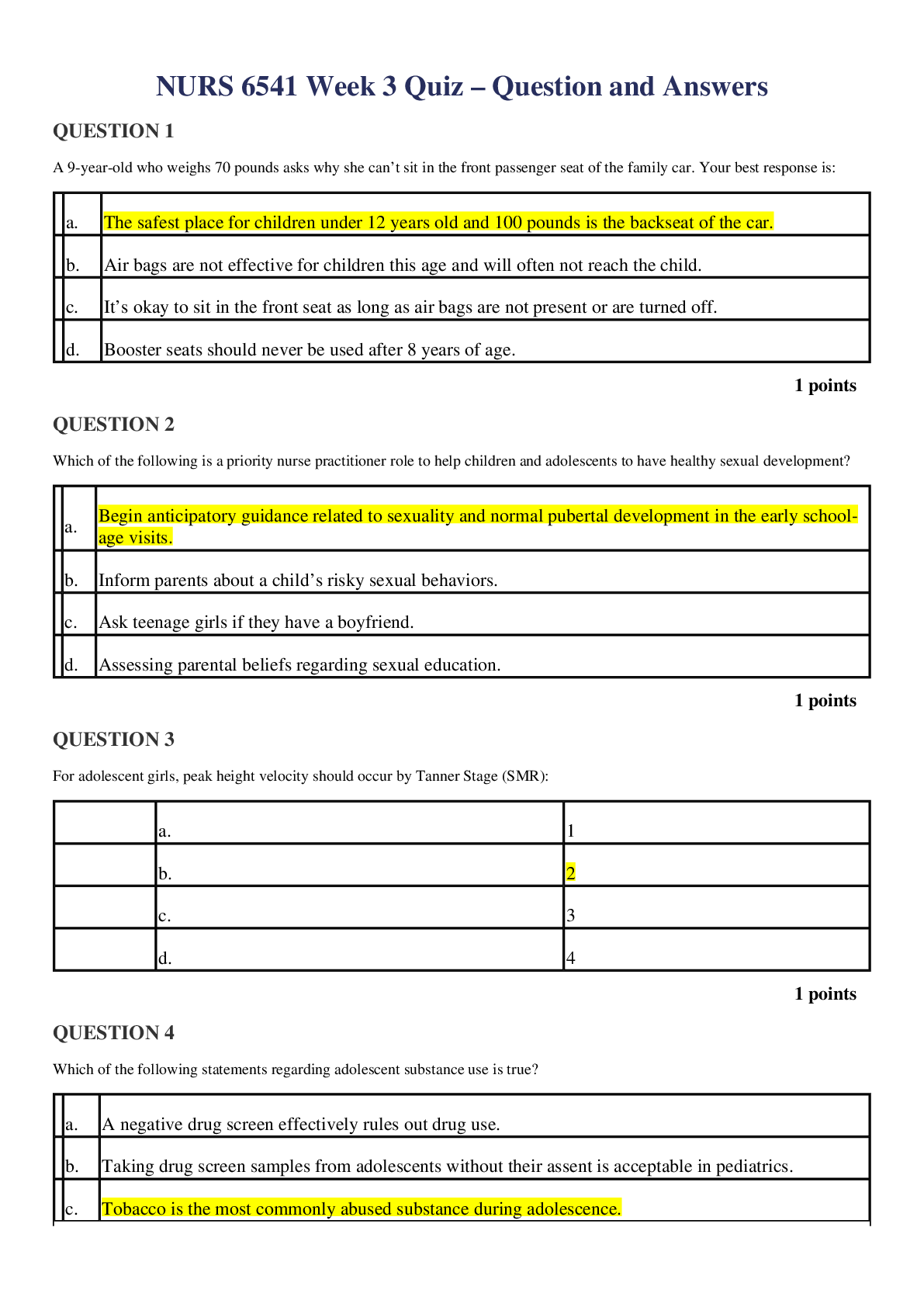
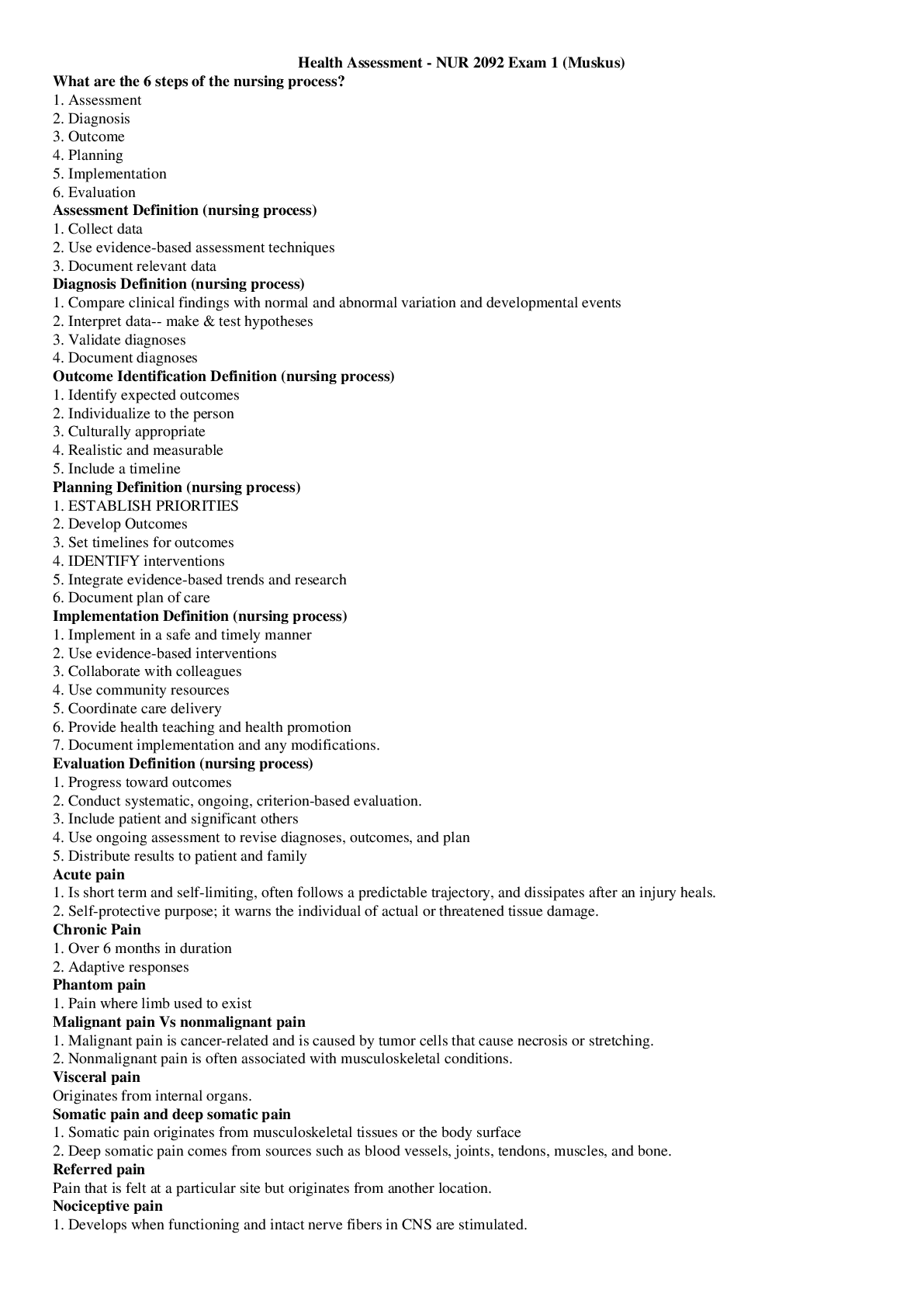
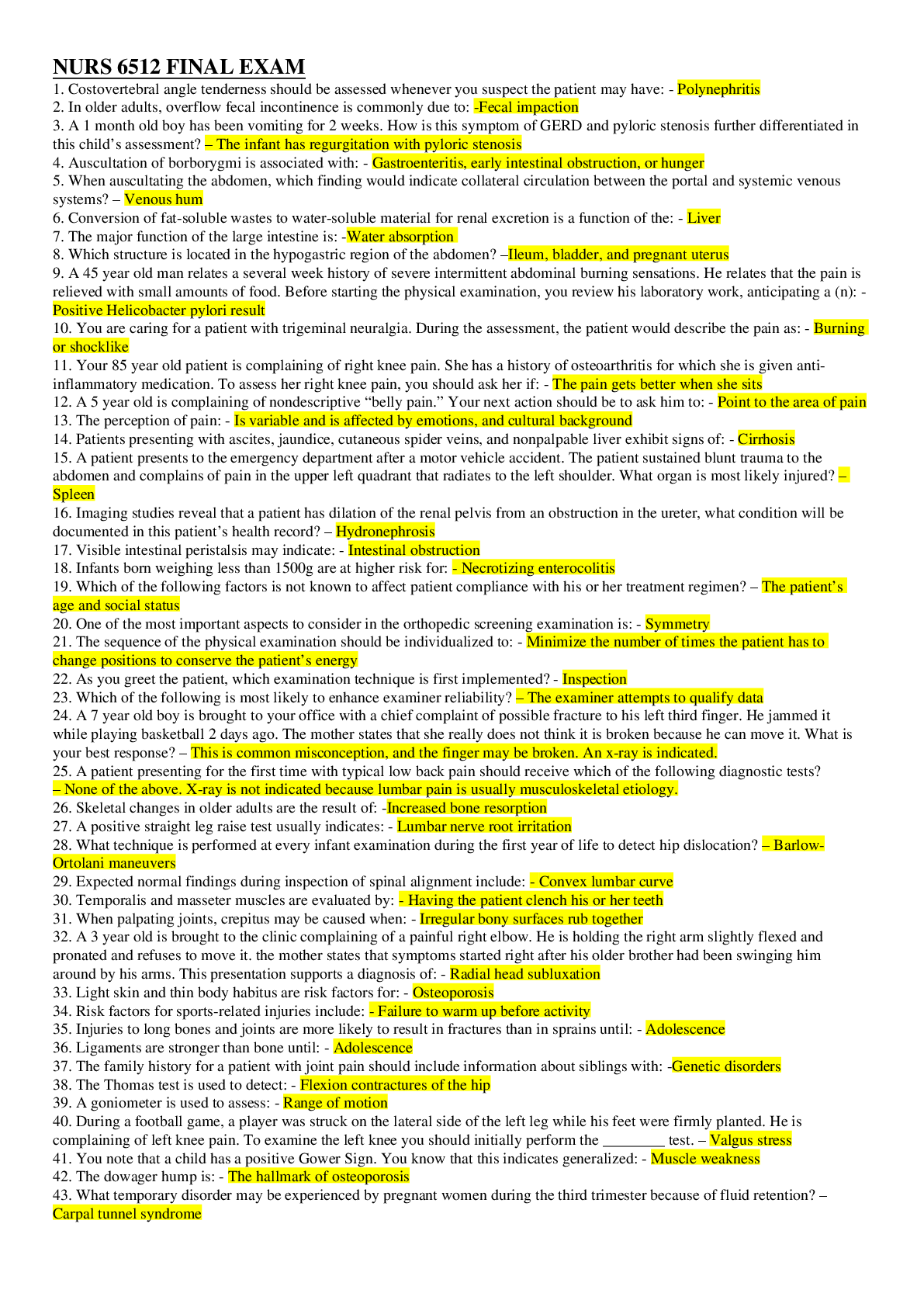
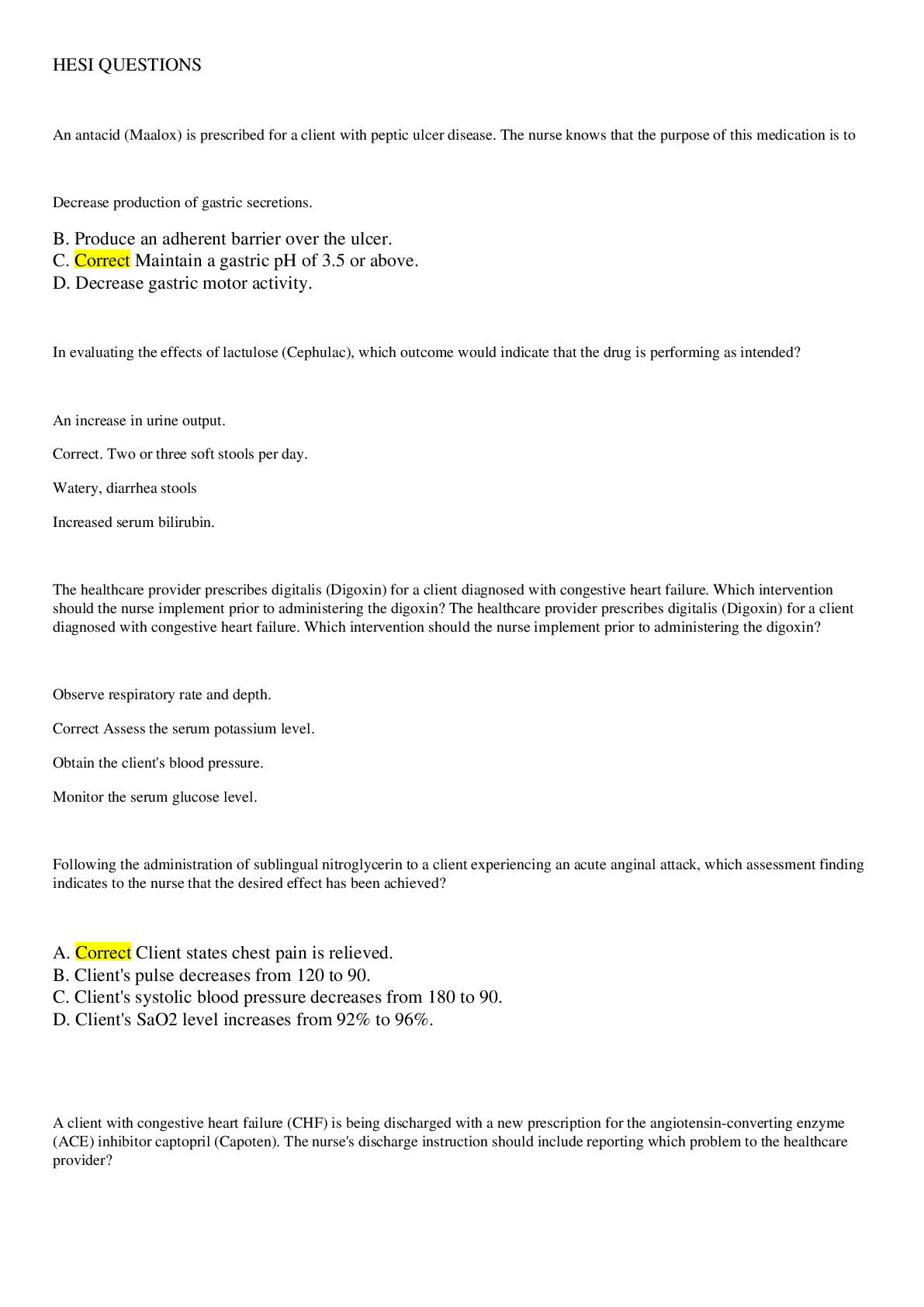

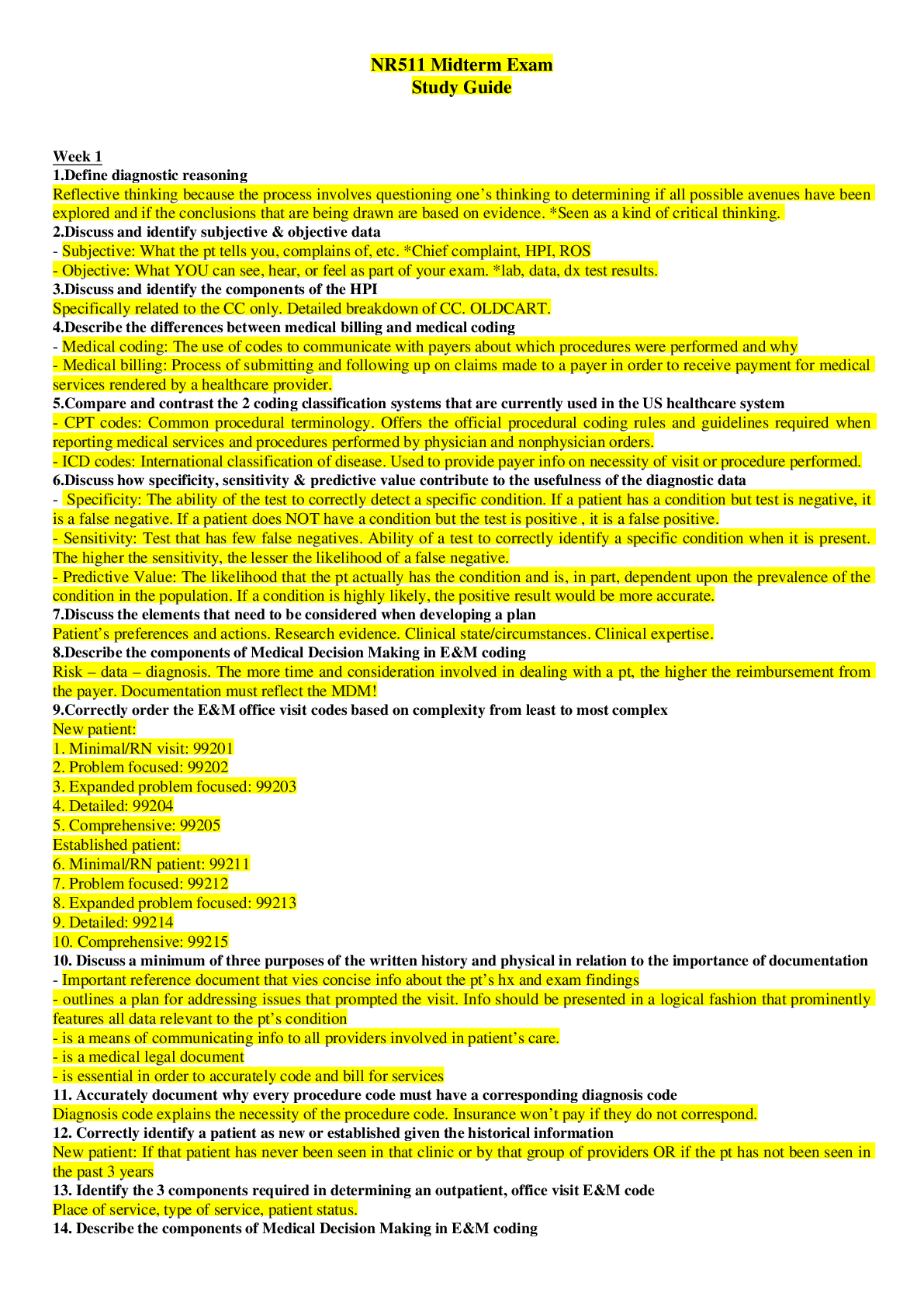

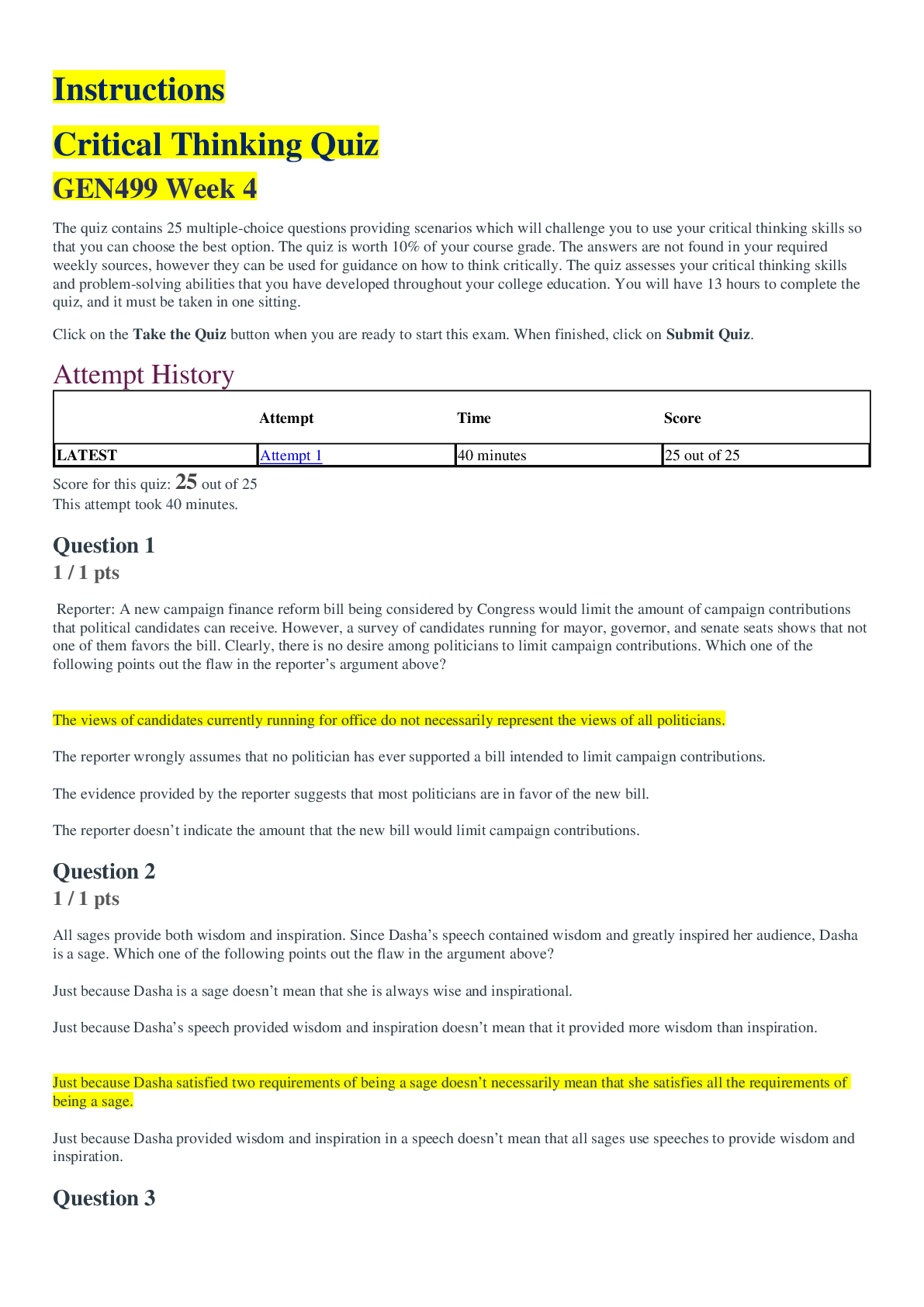
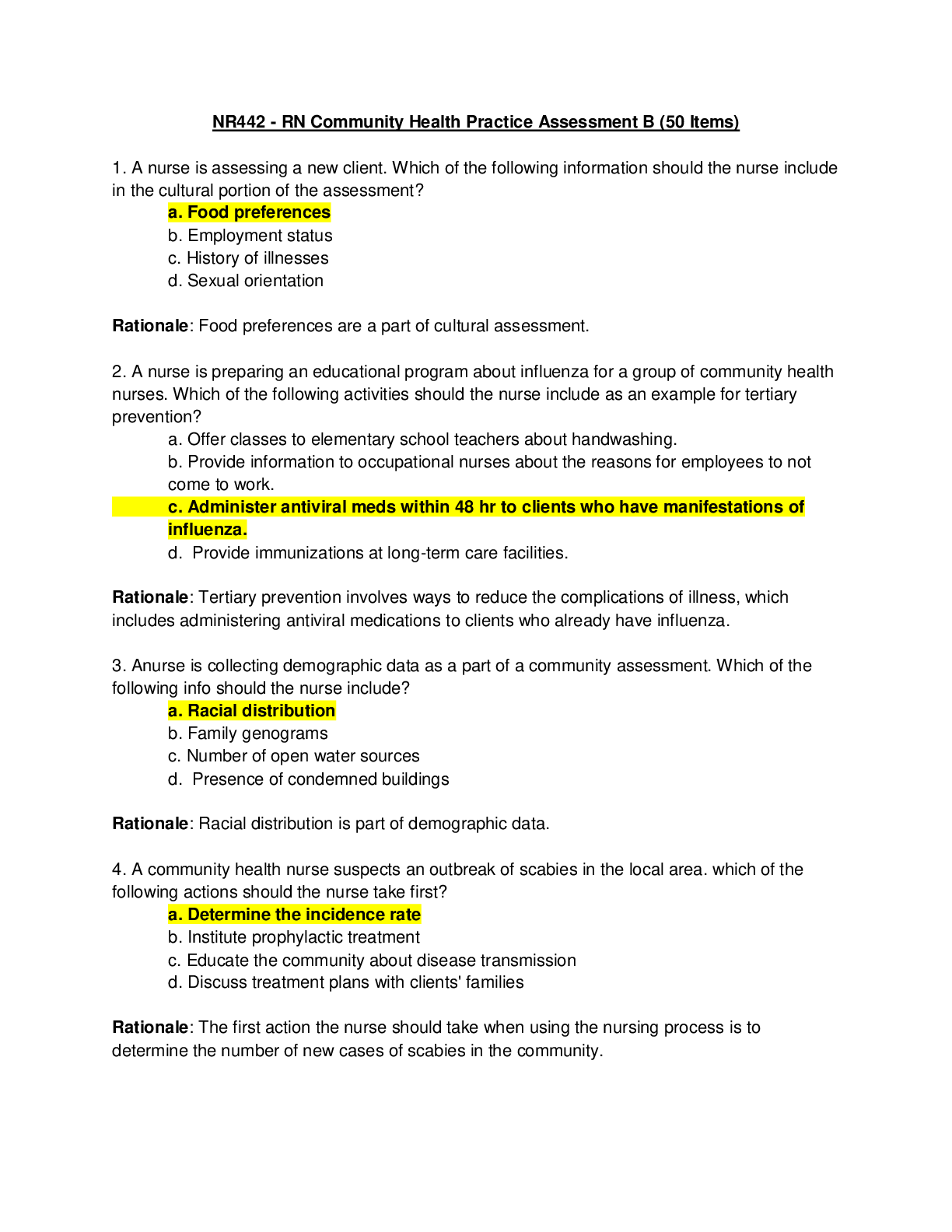
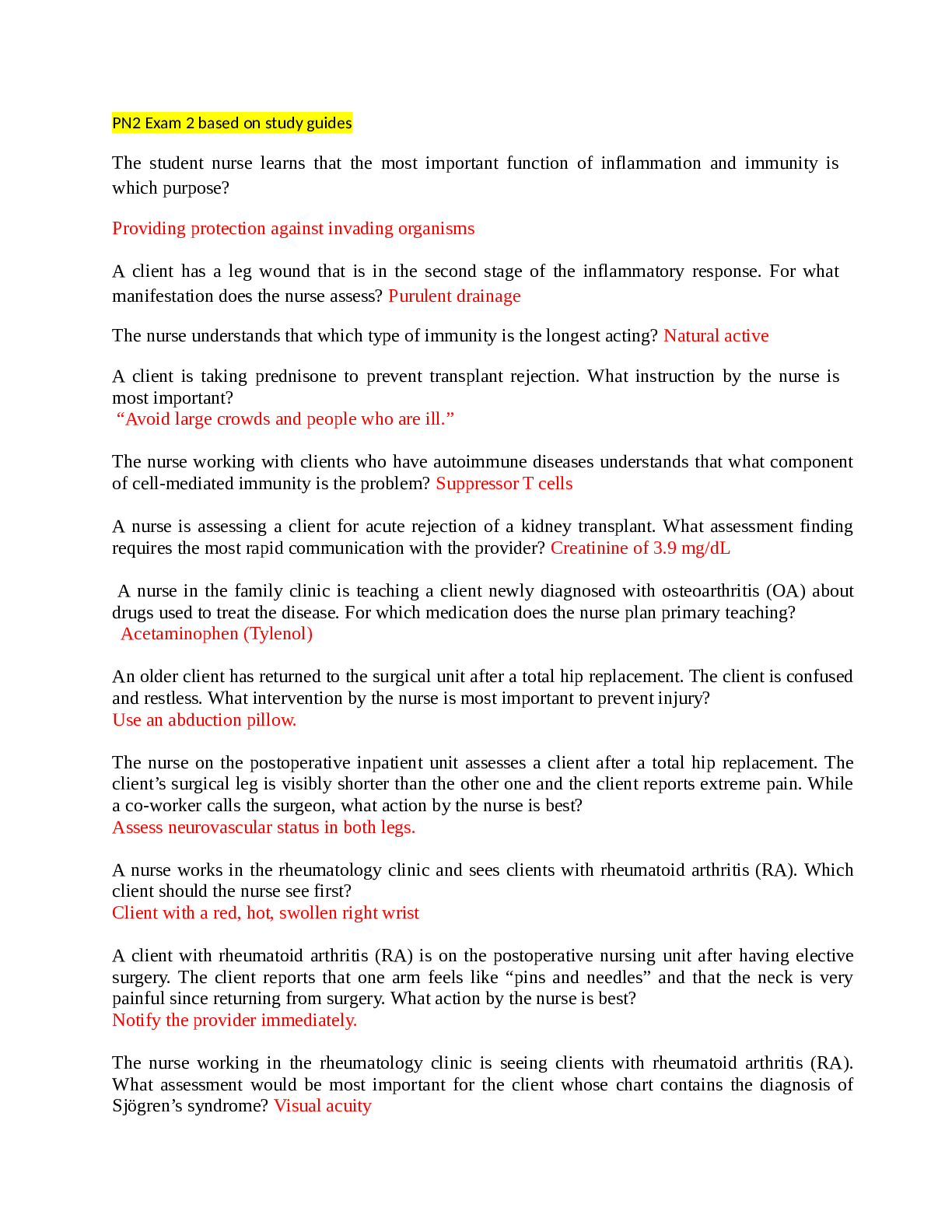

.png)

